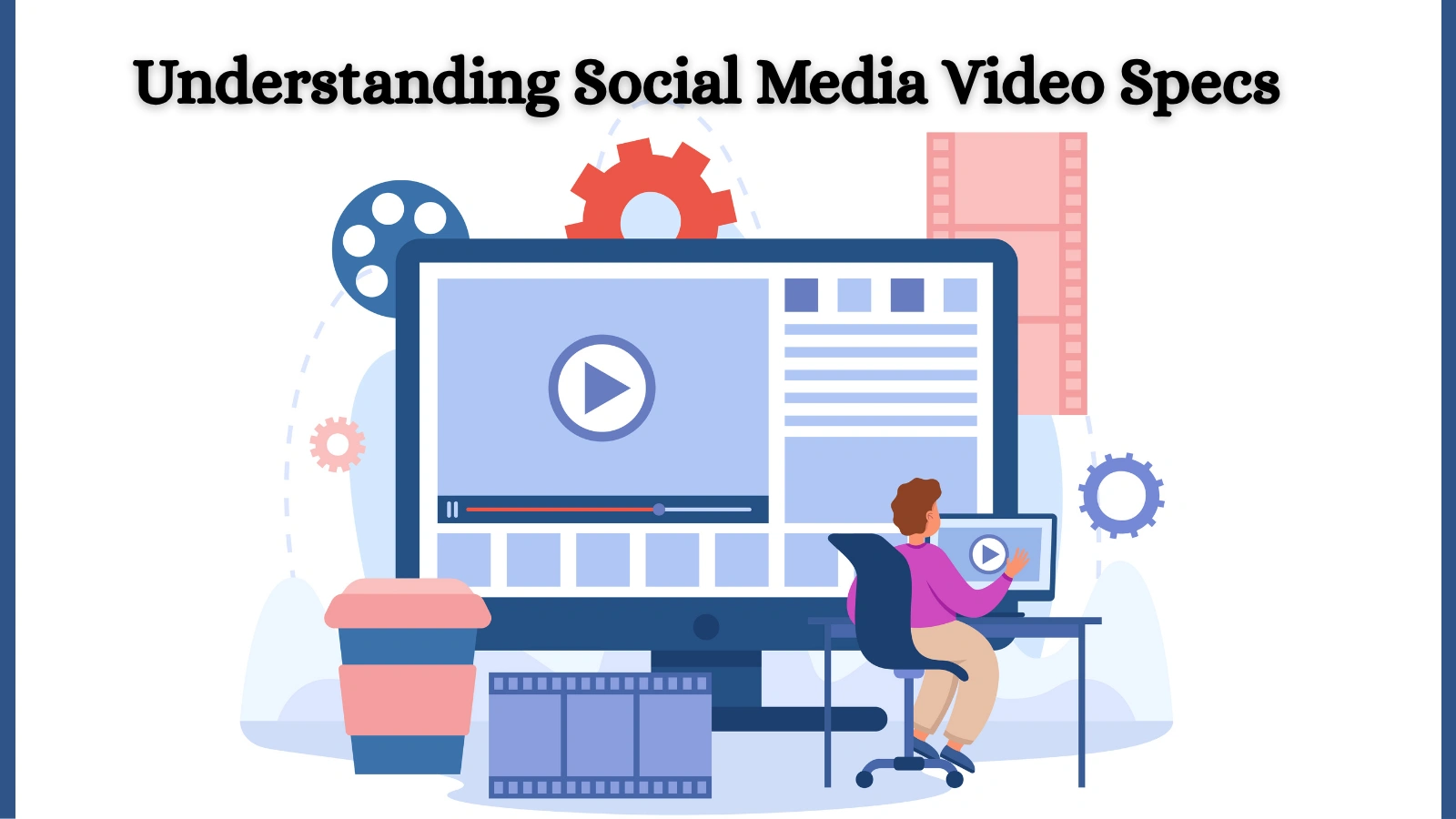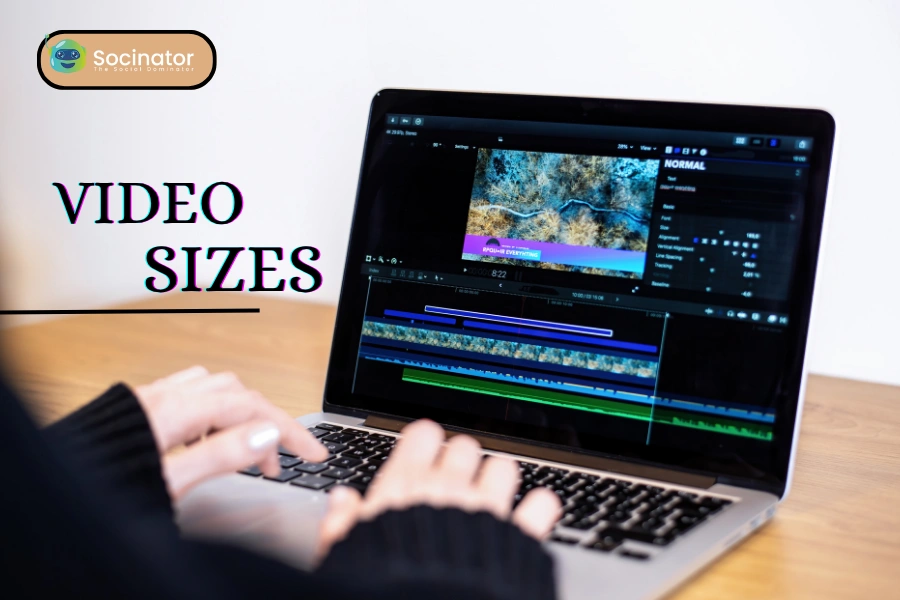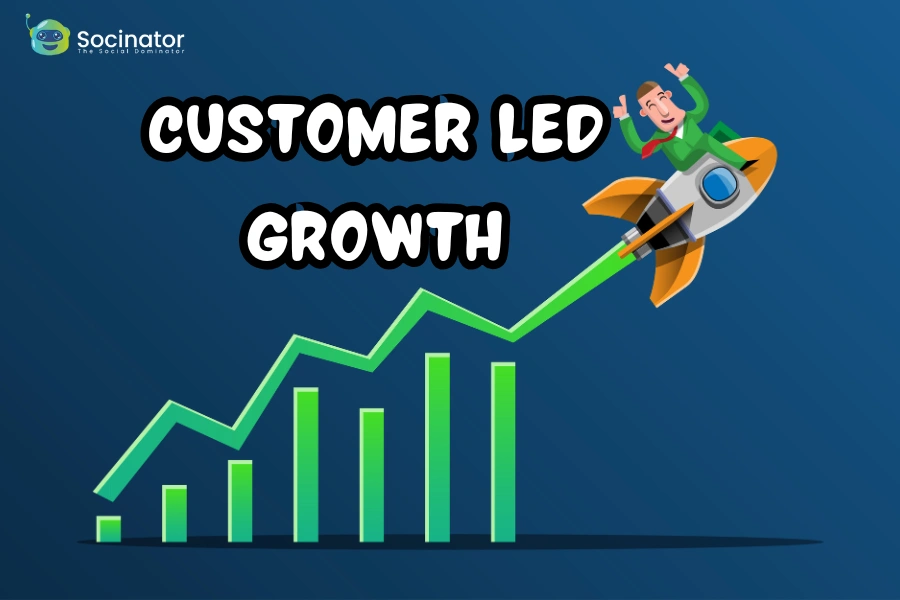Video has become the most powerful way to communicate across social platforms. From short-form reels to long-form tutorials, content thrives when it fits the right dimensions. The challenge is that every network has unique requirements. A video that looks perfect on Instagram might appear cropped or blurry on LinkedIn. That’s why understanding video sizes is essential for brand consistency, audience engagement, and professional appeal.
This guide breaks down everything you need to know, from social media video specs and dimensions to platform-specific recommendations. You will also see how automation with Socinator can help streamline your efforts and keep your content optimized for every platform.
Hit ‘Play’ Button & Tune Into The Blog!
Understanding Social Media Video Specs
 Every platform comes with its own set of social media video specs that determine how well your content displays. These include resolution, aspect ratio, file size, frame rate, and format. Each factor directly impacts how viewers experience your videos.
Every platform comes with its own set of social media video specs that determine how well your content displays. These include resolution, aspect ratio, file size, frame rate, and format. Each factor directly impacts how viewers experience your videos.
Resolution
Resolution refers to the number of pixels in a video frame, which affects its clarity and sharpness. A higher resolution, like 1080p or 4K, produces crisp visuals, while lower resolutions may appear blurry. Matching the recommended resolution ensures your content looks clear across all devices.
Aspect Ratio
Aspect ratio refers to the proportional relationship between the width and height of a video. Popular ratios include 16:9 for widescreen, 9:16 for vertical videos, and 1:1 for square posts. Choosing the right ratio prevents awkward cropping and keeps your video aligned with platform layouts.
File Size
File size measures how much storage space a video requires, which influences upload speed and playback quality. Large files may take longer to upload and can cause buffering issues, while smaller files may lose clarity. Balancing compression and quality ensures smooth sharing without distortion.
Frame Rate
Frame rate indicates the number of frames displayed per second (fps) in a video. Standard rates like 30fps create natural motion, while 60fps delivers smoother, high-quality playback for action shots. Sticking to the right frame rate ensures your videos look professional and flow seamlessly.
Format
Format determines the file type your video is saved in, with MP4 and MOV being the most widely accepted on social platforms. The correct format ensures compatibility, quick uploads, and high-quality playback. Using the wrong format may cause rejection or playback errors on some networks.
By following these social media video specs, you prevent issues like black borders, cropped visuals, or pixelation. Optimized videos not only look professional but also boost engagement by providing a smooth viewing experience.
Social Media Video Sizes Explained
The idea of video sizes is more than just pixel count; it’s about making sure your content matches where it will be displayed. Whether it’s feeds, stories, ads, or reels, the right size ensures videos look appealing and capture attention.
Square (1:1)
Square videos are versatile and perform effectively across multiple social media platforms. They provide balanced visibility on both desktop and mobile devices, making them an effective choice for organic posts and advertisements. This format maximizes screen space without obscuring important visuals.
Vertical (9:16)
Vertical videos dominate platforms like Instagram Stories, Reels, and TikTok, where most users watch content on mobile. This format fills the entire screen, creating an immersive experience. Brands use it to grab quick attention and boost engagement on mobile-first platforms.
Horizontal (16:9)
Horizontal videos remain the go-to format for YouTube and widescreen displays. They’re best for long-form content like tutorials, product demos, or interviews. This size delivers a cinematic feel and works perfectly when viewers watch on larger screens.
Each platform treats content differently, so sticking to one format doesn’t work. Adapting video sizes for social media ensures your content displays correctly, avoids cropping issues, and delivers the best possible viewing experience.
Social Media Video Dimensions You Should Know
 Dimensions play a crucial role because they decide how your video appears across devices. Using the right social media video dimensions ensures clarity, proper alignment, and a polished look, no matter where your audience views it.
Dimensions play a crucial role because they decide how your video appears across devices. Using the right social media video dimensions ensures clarity, proper alignment, and a polished look, no matter where your audience views it.
1080 x 1080 – Square Format
This dimension is perfect for balanced viewing on both mobile and desktop feeds. It gives equal space on all sides, keeping visuals centered without distractions. Square videos are especially effective for ads and organic posts where consistent visibility matters.
1080 x 1920 – Vertical Format
Designed for mobile-first platforms, this dimension fills the entire screen on stories and reels. It creates an immersive viewing experience, drawing viewers’ focus directly to the content. Brands use this format to connect quickly with mobile audiences who scroll fast.
1920 x 1080 – Horizontal Format
This widescreen option remains the standard for YouTube, webinars, and desktop viewing. It provides a cinematic look, making it ideal for tutorials, product launches, and long-form content. Horizontal videos are also great for maintaining professional quality on larger displays.
When creators overlook proper social media video dimensions, important details can get cut off. Logos, captions, or product visuals may disappear from view, reducing the effectiveness of the content. For professionals aiming to maximize reach, mastering these dimensions is no longer optional; it’s a must.
Video Sizes for Social Media Platforms (Platform-Wise Breakdown)
Every platform has its own recommended social media video sizes, designed to match how users interact with content. Using the right dimensions ensures that videos display correctly, maintain quality, and keep viewers engaged.
- Feed videos: 1080 x 1080 (1:1) – Balanced for mobile and desktop viewing.
- Stories/Reels: 1080 x 1920 (9:16) – Full-screen experience on mobile.
- Ads: 1200 x 628 – Horizontal format works best for sponsored placements.
Facebook supports multiple placements, so tailoring videos to each ensures better engagement and ad performance.
- Feed videos: 1080 x 1350 (4:5) – Tall enough to stand out in the feed.
- Reels/Stories: 1080 x 1920 (9:16) – Designed for immersive, vertical viewing.
- IGTV/Long-form: 1920 x 1080 pixels (16:9 aspect ratio) – Ideal for longer video content.
Instagram is highly visual, so choosing the right size helps avoid awkward cropping and improves content visibility.
LinkedIn video dimensions are tailored for a professional audience.
- Feed videos: 1080 x 1080 (1:1) or 1920 x 1080 (16:9) – Suitable for organic posts.
- Ads: Minimum 640 x 360, maximum 1920 x 1080 – Flexible for campaigns.
Maintaining the correct LinkedIn video dimensions ensures your business content appears sharp, credible, and effective in building brand authority.
Twitter (X)
- Feed videos: 1200 x 1200 (1:1) – Square format for quick engagement.
- Landscape: 1280 x 720 (16:9) – Perfect for widescreen clips.
- Vertical: 720 x 1280 (9:16) – Fits mobile-first viewers.
Twitter supports different formats, so creators can test which dimension delivers the most engagement.
YouTube
- Standard videos: 1920 x 1080 (16:9) – The gold standard for YouTube uploads.
- Shorts: 1080 x 1920 (9:16) – Optimized for mobile-first content.
- Aspect ratio: 16:9 recommended for widescreen displays.
For YouTube, maintaining proper video sizes is essential since it’s a platform built entirely around video content.
TikTok
- Default videos: 1080 x 1920 (9:16) – Vertical short-form dominates the platform.
TikTok thrives on quick, vertical videos. Matching its format boosts discoverability and keeps your content trending.
- Standard pins: 1000 x 1500 (2:3) – Works well for static visuals and videos.
- Video pins should be formatted at 1080 x 1920 (9:16) to ensure they are optimized for vertical mobile viewing.
Pinterest emphasizes visual appeal, so optimized social media video sizes are key to standing out on boards and searches.
Every network handles content differently. Ignoring platform-specific social media video sizes can result in distorted visuals, cropped frames, and lower engagement. By adapting to each platform’s requirements, you ensure maximum reach and professionalism in your content strategy.
How Long Should A Social Media Video Be?
Marketers often inquire about the ideal length for a social media video. The optimal duration depends on the platform and audience behavior.
Facebook – Videos between 1–2 minutes perform best as they are long enough to deliver value but short enough to keep attention.
Instagram Reels – 15–60 seconds work well since Reels are designed for quick, engaging, and easily consumable content.
LinkedIn – 30 seconds to 2 minutes is ideal for professional updates, insights, or thought leadership, balancing depth with audience focus.
YouTube – 7–15 minutes is effective for tutorials and in-depth content, while 15–60 seconds is perfect for Shorts and bite-sized videos.
TikTok – 15–60 seconds tends to capture fast attention spans, maximizing reach and completion rates.
Shorter videos generally outperform longer ones on most platforms, but the key is aligning video length with your audience’s intent and patience.
Read More!
The Ultimate Updated Guide To Social Media Post Dimensions
Instagram videos: How long should your videos be for them to be a masterpiece?
Choosing The Best Social Media Video Formats
The format you choose directly impacts how smoothly your videos play across platforms. The two most common and widely accepted social media video formats are MP4 and MOV.
MP4 – Known for its universal compatibility, MP4 offers smaller file sizes and faster upload times while maintaining good quality. This makes it the go-to choice for most creators.
MOV – Popular among professionals, MOV files deliver higher video quality but come with larger file sizes. They’re especially useful during editing when you want to preserve maximum detail.
For seamless publishing across multiple platforms, MP4 is usually the safest option. Still, it’s smart to review each platform’s specifications, as some ad placements or features may favor one format over the other.
Mistakes To Avoid With Social Media Video Specs
Many brands miss out on engagement because they overlook simple but critical video requirements. Here are common pitfalls to avoid:
- Uploading the wrong video sizes – Incorrect dimensions can lead to cropped visuals or stretched frames, cutting off key details like logos or captions.
- Ignoring platform-specific specs – Skipping recommended sizes, formats, or aspect ratios often results in poor playback and reduced visibility.
- Using low resolution – Blurry or pixelated videos harm credibility, making the content appear unprofessional and less trustworthy.
- Forgetting captions – Without captions, videos lose accessibility for hearing-impaired viewers and people watching on mute, which lowers engagement.
- Failing to adapt content – Posting the same video everywhere without adjustments can reduce impact, as each platform has unique audience behaviors and specs.
By following accurate video dimensions, resolutions, and formats, brands ensure their content looks sharp, accessible, and engaging across all platforms.
How Socinator Makes Social Media Automation Easy?
 Managing multiple platforms with unique video size requirements can be stressful. Socinator removes this burden by automating tasks and ensuring your social media strategy stays consistent, organized, and efficient.
Managing multiple platforms with unique video size requirements can be stressful. Socinator removes this burden by automating tasks and ensuring your social media strategy stays consistent, organized, and efficient.
Key Features of Socinator
Social Media Scheduling
With Socinator, you can plan and schedule posts across multiple social media platforms from a single dashboard. It supports Instagram, Facebook, Twitter, YouTube, Pinterest, and more, allowing you to efficiently manage all your accounts in one place. Socinator automatically publishes your content at peak engagement times, ensuring maximum reach and consistency without the need for manual posting.
Content & Messaging Management
Instead of juggling multiple files and conversations, Socinator allows you to store, organize, and manage your content and communications in one place. Along with managing your posts, it also enables you to broadcast direct messages across multiple accounts, send automated replies, and engage with your audience at scale. You can repurpose evergreen content for continuous engagement while simultaneously nurturing your followers with personalized automated messages, all from a single unified dashboard.
Automation Tools – Boost Engagement with Zero Manual Effort
Socinator offers powerful automation features that replicate human-like actions to consistently grow your account while saving time. Here’s how each feature works:
1. Auto Like
Automatically likes posts from targeted users, hashtags, or niches. This helps you get noticed by real audiences, attract profile visits, and build engagement organically.
2. Auto Follow
Socinator automatically follows users based on your set criteria, such as interests, demographics, or hashtags, helping you grow your follower base with relevant audiences.
3. Auto Unfollow
To maintain a healthy follower-to-following ratio, Socinator unfollows inactive or non-mutual accounts automatically, helping you keep your profile credible.
4. Auto Comment
Engage with posts in your industry by leaving targeted and customized comments on relevant profiles. This increases visibility and encourages users to check your account.
5. Auto View Stories
View others’ stories automatically to increase visibility and draw attention to your profile. Many users check who viewed their stories and tend to engage back.
6. Auto Publish & Scheduler
Plans and publishes posts at the best times for engagement across multiple social media platforms, all without manual intervention.
Socinator also offers tutorials, live demos, and cross-platform support for Windows, macOS, and Linux. Whether you’re a small business, an agency, or an enterprise, Socinator adapts to your workflow and saves valuable time.
By automating video publishing, marketers no longer stress over different platform specs. Socinator ensures every video is published in the right size, on the right platform, and at the right time consistently.
Read More!
18 Proven Tips To Master Social Media Videos
Final Tips On Social Media Video Sizes
Check updated guidelines – Platforms frequently update their requirements, so always review the latest specs to avoid issues with uploads or playback.
Use templates for resizing – Design templates make it easy to adapt your videos for multiple formats, saving time while keeping your visuals consistent.
Leverage automation tools – Tools like Socinator simplify publishing by adjusting to each platform’s standards, ensuring accuracy and efficiency.
Test and analyze performance – Experiment with different video sizes for social media, then track analytics to discover which formats deliver the best engagement.
Conclusion
The right video sizes ensure your content fits every platform perfectly. When creators optimize social media video specs, dimensions, and formats, their videos look professional, attract attention, and drive results. Each platform, from Instagram and LinkedIn to TikTok and YouTube, requires unique adjustments.
With tools like Socinator, the process becomes seamless. You can automate publishing, maintain consistency, and focus on creating engaging videos while the software handles the rest. Choosing the correct social media video sizes is no longer a challenge when paired with the right strategy and automation.
FAQs
- Why do video sizes matter on social media?
Using the correct video sizes prevents awkward cropping and distortion. It also maintains visual clarity, ensures your branding elements stay visible, and boosts overall engagement.
- What are the best social media video formats?
The most widely accepted format is MP4, as it balances quality with small file sizes and faster uploads. MOV is also popular, offering higher quality but with larger file sizes, making it ideal for editing.
- How long should a social media video be?
Short videos between 15 and 60 seconds usually perform best on platforms like Instagram, TikTok, and Facebook. For YouTube, longer videos (7–15 minutes) work well for tutorials, while Shorts thrive under one minute.






